Peer-Reviewed Journal Articles
 Welcome to our research library! We understand that finding reputable scientific literature with public access can be difficult and frustrating. Here, we regularly update our database with peer-reviewed, published scientific articles with “open access” so that anyone may access the full text. We urge everyone to research topics that interest them. Don’t hesitate to reach out to us with any additional requests.
Welcome to our research library! We understand that finding reputable scientific literature with public access can be difficult and frustrating. Here, we regularly update our database with peer-reviewed, published scientific articles with “open access” so that anyone may access the full text. We urge everyone to research topics that interest them. Don’t hesitate to reach out to us with any additional requests.
Index
Acute Pain
 Title: Transcutaneous electrical nerve stimulation for relieving acute pain in the prehospital setting: a systematic review and meta-analysis of randomized-controlled trials
Title: Transcutaneous electrical nerve stimulation for relieving acute pain in the prehospital setting: a systematic review and meta-analysis of randomized-controlled trials
Authors: Simpson, Paul M.; Fouche, Peiter F.; Thomas, Richard E.; Bendall, Jason C.
Journal: European Journal of Emergency Medicine
Abstract: Although medics in many services are equipped with pharmacological analgesia, legislative or logistical restrictions in some systems result in the need to rely on nonpharmacological avenues for the management of acute pain. Transcutaneous electrical nerve stimulation (TENS) has been proposed as an alternative to analgesic medication that could be feasible and effective in the prehospital setting. The aim of this systematic review was to determine the effectiveness and safety of TENS when administered by medics to patients with acute pain in the prehospital setting. A systematic literature review was carried out to identify randomized-controlled trials investigating the safety and efficacy of TENS compared with ‘sham’ (placebo) TENS in the prehospital setting. Quality assessment of included studies was carried out to identify potential for bias. Qualitative and quantitative synthesis of results was performed to determine effectiveness and safety. The studies included were meta-analysed using a random-effects model to produce pooled results for comparison of the mean post-treatment pain scores using a visual analogue scale (VAS). Four studies were included in the analysis, all of which were prospective clinical trials of good methodological quality. Meta-analysis indicated that TENS produced a clinically significant reduction in severity of pain [mean VAS reduction 38 mm (95% confidence interval 28–44); P<0.0001] for patients with moderate-to-severe acute pain. TENS produced post-treatment mean pain scores that were significantly lower than ‘sham’ TENS [33 mm VAS (95% confidence interval 21–44); P<0.0001]. TENS was also effective in reducing acute anxiety secondary to pain. No safety risks were identified. When administered by medics in the prehospital setting to patients with acute pain, TENS appears to be an effective and safe nonpharmacological analgesic modality that should be considered by emergency medical services organizations in which pharmacological pain management is restricted or unavailable.
Link to Full Article
Back Pain
Title: Cell-Based Therapies Used to Treat Lumbar Degenerative Disc Disease: A Systematic Review of Animal Studies and Human Clinical Trials
Authors: David Oehme, Tony Goldschlager, Peter Ghosh, Jeffrey V. Rosenfeld, and Graham Jenkin
Journal: Stem Cells International
Abstract: Low back pain and degenerative disc disease are a significant cause of pain and disability worldwide. Advances in regenerative medicine and cell-based therapies, particularly the transplantation of mesenchymal stem cells and intervertebral disc chondrocytes, have led to the publication of numerous studies and clinical trials utilising these biological therapies to treat degenerative spinal conditions, often reporting favourable outcomes. Stem cell mediated disc regeneration may bridge the gap between the two current alternatives for patients with low back pain, often inadequate pain management at one end and invasive surgery at the other. Through cartilage formation and disc regeneration or via modification of pain pathways stem cells are well suited to enhance spinal surgery practice. This paper will systematically review the current status of basic science studies, preclinical and clinical trials utilising cell-based therapies to repair the degenerate intervertebral disc. The mechanism of action of transplanted cells, as well as the limitations of published studies, will be discussed.
Link to Full Text
Title: Medical Ozone in Herniated Disc: A Classical Review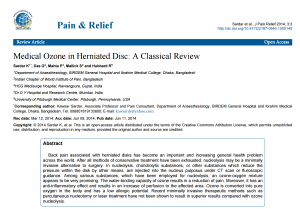
Authors: Sardar K, Das G, Mahta P, Mallick S and Hubbard R
Journal: Pain & Relief
Abstract: Back pain associated with herniated disks has become an important and increasing general health problem across the world. After all methods of conservative treatment have been exhausted, nucleolysis may be a minimally invasive alternative to surgery. In nucleolysis, chondrolytic substances, or other substances which reduce the pressure within the disk by other means, are injected into the nucleus pulposus under CT scan or fluroscopic guidance. Among various substances, which have been employed for nucleolysis, an ozone-oxygen mixture appears to be very promising. The water-binding capacity of ozone results in a reduction of pain. Moreover, it has an anti-inflammatory effect and results in an increase of perfusion to the affected area. Ozone is converted into pure oxygen in the body and has a low allergic potential. Recent minimally invasive therapeutic methods such as percutaneous nucleotomy or laser treatment have not been shown to result in superior results compared with ozone nucleolysis.
Link to Full Text
Bulging Disc
Title: Transforaminal Epidural Injections in Chronic Lumbar Disc Herniation: A Randomized, 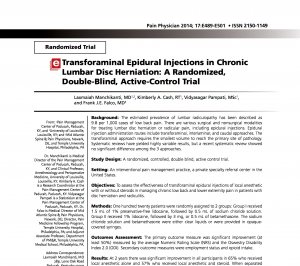 Double-Blind, Active-Control Trial
Double-Blind, Active-Control Trial
Authors: Laxmaiah Manchikanti, MD, Kimberly A. Cash, RT, Vidyasagar Pampati, MSc,
and Frank J.E. Falco, MD
Journal: Pain Physician
Abstract: Background: The estimated prevalence of lumbar radiculopathy has been described as
9.8 per 1,000 cases of low back pain. There are various surgical and nonsurgical modalities
for treating lumbar disc herniation or radicular pain, including epidural injections. Epidural
injection administration routes include transforaminal, interlaminar, and caudal approaches. The
transforaminal approach requires the smallest volume to reach the primary site of pathology.
Systematic reviews have yielded highly variable results, but a recent systematic review showed
no significant difference among the 3 approaches. Study Design: A randomized, controlled, double blind, active control trial. Setting: An interventional pain management practice, a private specialty referral center in the United States. Objectives: To assess the effectiveness of transforaminal epidural injections of local anesthetic with or without steroids in managing chronic low back and lower extremity pain in patients with disc herniation and radiculitis. Methods: One hundred twenty patients were randomly assigned to 2 groups: Group I received
1.5 mL of 1% preservative-free lidocaine, followed by 0.5 mL of sodium chloride solution.
Group II received 1% lidocaine, followed by 3 mg, or 0.5 mL of betamethasone. The sodium
chloride solution and betamethasone were either clear liquids or were provided in opaquecovered
syringes. Outcomes Assessment: The primary outcome measure was significant improvement (at
least 50%) measured by the average Numeric Rating Scale (NRS) and the Oswestry Disability
Index 2.0 (ODI). Secondary outcome measures were employment status and opioid intake. Results: At 2 years there was significant improvement in all participants in 65% who received
local anesthetic alone and 57% who received local anesthetic and steroid. When separated
into non-responsive and responsive categories based on initial relief of at least 3 weeks with 2
procedures, significant improvement (at least 50% improvement in pain and function) was seen
in 80% in the local anesthetic group and 73% in the local anesthetic with steroid group.
Limitations: Presumed limitations of this evaluation include the lack of a placebo group. Conclusion: Transforaminal epidural injections of local anesthetic with or without steroids
might be an effective therapy for patients with disc herniation or radiculitis. The present evidence illustrates the lack of superiority of steroids compared with local anesthetic at 2-year follow-up.
Link to Full Text
Carpal Tunnel Syndrome
Title: Treatment outcome in carpal tunnel syndrome: Does distribution of sensory symptoms matter? 
Authors: Franka Claesa, Kristel M. Kasiusb, Jan Meulsteec, J. André Grotenhuisd, Wim I.M. Verhagenc
Journal: Journal of Neurological Sciences
Abstract:Background Patients with complaints of carpal tunnel syndrome (CTS) with signs and symptoms not exclusively confined to the median nerve territory, but otherwise fulfilling the clinical criteria may erroneously be withheld from therapy. Methods One hundred and twenty one patients who fulfilled the clinical criteria for the diagnosis of CTS with signs and symptoms restricted to the median nerve territory (group A) and 91 patients without this restriction (group B) were included in a prospective cohort study. All patients fulfilled electrodiagnostic criteria of CTS. Outcome was determined after 7 to 9 months by means of Symptom Severity Score (SSS) and Functional Status Score (FSS) according to Levine and a patient satisfaction questionnaire. Results Response rates were 81.8% (group A) and 82.4% (group B). All patients in group B had sensory symptoms involving digit 5. There were no significant differences in improvement of SSS, FSS and patient satisfaction scores between groups after treatment. Conclusion CTS patients with characteristic sensory signs and symptoms not exclusively restricted to the median nerve innervated area should be treated in the same manner as patients with CTS symptoms restricted to the median nerve innervated area and should therefore not be withheld from surgical treatment.
Link to Full Text
Chronic Pain
Title: Ketamine for chronic pain: risks and benefits.
Authors: Niesters, M., Martini, C. and Dahan, A.
Journal: Journal of Clinical Pharmacology
Abstract: The anaesthetic ketamine is used to treat various chronic pain syndromes, especially those that have a neuropathic component. Low dose ketamine produces strong analgesia in neuropathic pain states, presumably by inhibition of the N-methyl-D-aspartate receptor although other mechanisms are possibly involved, including enhancement of descending inhibition and anti-inflammatory effects at central sites. Current data on short term infusions indicate that ketamine produces potent analgesia during administration only, while three studies on the effect of prolonged infusion (4–14 days) show long-term analgesic effects up to 3 months following infusion. The side effects of ketamine noted in clinical studies include psychedelic symptoms (hallucinations, memory defects, panic attacks), nausea/vomiting, somnolence, cardiovascular stimulation and, in a minority of patients, hepatoxicity. The recreational use of ketamine is increasing and comes with a variety of additional risks ranging from bladder and renal complications to persistent psychotypical behaviour and memory defects. Blind extrapolation of these risks to clinical patients is difficult because of the variable, high and recurrent exposure to the drug in ketamine abusers and the high frequency of abuse of other illicit substances in this population. In clinical settings, ketamine is well tolerated, especially when benzodiazepines are used to tame the psychotropic side effects. Irrespective, close monitoring of patients receiving ketamine is mandatory, particularly aimed at CNS, haemodynamic, renal and hepatic symptoms as well as abuse. Further research is required to assess whether the benefits outweigh the risks and costs. Until definite proof is obtained ketamine administration should be restricted to patients with therapy-resistant severe neuropathic pain.
Link to Full Text
Title: Influence of ketamine and morphine on descending pain modulation in chronic pain patients: a randomized placebo-controlled cross-over proof-of-concept study
Authors: M. Niesters, L. Aarts, E. Sarton and A. Dahan
Journal: British Journal of Anesthesia
Abstract: Background Descending inhibition of pain, part of the endogenous pain modulation system, is important for normal pain processing. Dysfunction is associated with various chronic pain states. Here, the effect of ketamine and morphine on descending inhibition is examined using the conditioned pain modulation (CPM) paradigm in chronic neuropathic pain patients.
Methods CPM responses were obtained in 10 adult neuropathic pain subjects (two men/eight women). All subjects had peripheral neuropathy as defined by abnormal quantitative sensory testing. The effects of S(+)-ketamine (0.57 mg kg–1 h–1 for 1 h) and morphine (0.065 mg kg−1 h−1 for 1 h) were tested in a randomized, placebo-controlled double-blind study. CPM was measured at baseline and 100 min after the start of treatment and was induced by immersion of the leg into a cold-water bath. The test stimulus was a 30 s static thermal stimulus to the skin of the forearm.
Results Without treatment, no CPM was detectable. Treatment with ketamine, morphine, and placebo produced CPM responses of 40.2 (10.9)%, 28.5 (7.0)%, and 22.1 (12.0)%, respectively (for all treatments, CPM effect P<0.05), with no statistical difference in the magnitude of CPM among treatments. The magnitude of CPM correlated positively with the magnitude and duration of spontaneous pain relief.
Conclusions The observed treatment effects in chronic pain patients suggest a role for CPM engagement in analgesic efficacy of ketamine, morphine, and placebo treatment.
Link to Full Text
Title: The Dose-Dependent Effect of S(+)-Ketamine on Cardiac Output in Healthy Volunteers and Complex Regional Pain Syndrome Type 1 Chronic Pain Patients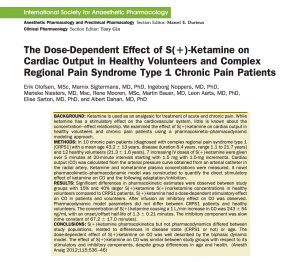
Authors: Olofsen, Erik MSc; Sigtermans, Marnix MD, PhD; Noppers, Ingeborg MD, PhD; Niesters, Marieke MD, Msc; Mooren, Rene MSc; Bauer, Martin MD; Aarts, Leon MD, PhD; Sarton, Elise MD, PhD; Dahan, Albert MD, PhD
Journal: Anesthesia & Analgesia
Abstract: BACKGROUND: Ketamine is used as an analgesic for treatment of acute and chronic pain. While ketamine has a stimulatory effect on the cardiovascular system, little is known about the concentration–effect relationship. We examined the effect of S(+)-ketamine on cardiac output in healthy volunteers and chronic pain patients using a pharmacokinetic–pharmacodynamic modeling approach.
METHODS: In 10 chronic pain patients (diagnosed with complex regional pain syndrome type 1 [CRPS1] with a mean age 43.2 ± 13 years, disease duration 8.4 years, range 1.1 to 21.7 years) and 12 healthy volunteers (21.3 ± 1.6 years), 7 increasing IV doses of S(+)-ketamine were given over 5 minutes at 20-minute intervals starting with 1.5 mg with 1.5-mg increments. Cardiac output (CO) was calculated from the arterial pressure curve obtained from an arterial catheter in the radial artery. Ketamine and norketamine plasma concentrations were measured. A novel pharmacokinetic–pharmacodynamic model was constructed to quantify the direct stimulatory effect of ketamine on CO and the following adaptation/inhibition.
RESULTS: Significant differences in pharmacokinetic estimates were observed between study groups with 15% and 40% larger S(+)-ketamine S(+)-norketamine concentrations in healthy volunteers compared to CRPS1 patients. S(+)-ketamine had a dose-dependent stimulatory effect on CO in patients and volunteers. After infusion an inhibitory effect on CO was observed. Pharmacodynamic model parameters did not differ between CRPS1 patients and healthy volunteers. The concentration of S(+)-ketamine causing a 1 L/min increase in CO was 243 ± 54 ng/mL with an onset/offset half-life of 1.3 ± 0.21 minutes. The inhibitory component was slow (time constant of 67.2 ± 17.0 minutes).
CONCLUSIONS: S(+)-ketamine pharmacokinetics but not pharmacodynamics differed between study populations, related to differences in disease state (CRPS1 or not) or age. The dose-dependent effect of S(+)-ketamine on CO was well described by the biphasic dynamic model. The effect of S(+)-ketamine on CO was similar between study groups with respect to its stimulatory and inhibitory components, despite group differences in age and health.
Link to Full Text
Title: Intravenous Infusions in Chronic Pain Management
Authors: Boleslav Kosharskyy, MD, Wilson Almonte, MD, Naum Shaparin, MD, Marco Pappagallo, MD, and Howard Smith, MD
Journal: Pain Physician
Abstract: In the United States, millions of Americans are affected by chronic pain, which adds heavily to national rates of morbidity, mortality, and disability, with an ever-increasing prevalence. According to a 2011 report titled Relieving Pain in America: A Blueprint for Transforming Prevention, Care, Education, and Research by the Institute of Medicine of the National Academies, pain not only exacts its toll on people’s lives but also on the economy with an estimated annual economic cost of at least $560 – 635 billion in health care costs and the cost of lost productivity attributed to chronic pain. Intravenous infusions of certain pharmacologic agents have been known to provide substantial pain relief in patients with various chronic painful conditions. Some of these infusions are better, and although not necessarily the first therapeutic choice, have been widely used and extensively studied. The others show promise, however are in need of further investigations. This article will focus on non-opiate intravenous infusions that have been utilized for chronic painful disorders such as fibromyalgia, neuropathic pain, phantom limb pain, post-herpetic neuralgia, complex regional pain syndromes (CRPS), diabetic neuropathy, and central pain related to stroke or spinal cord injuries. The management of patients with chronic pain conditions is challenging and continues to evolve as new treatment modalities are explored and tested. The following intravenous infusions used to treat the aforementioned chronic pain conditions will be reviewed: lidocaine, ketamine, phentolamine, dexmedetomidine, and bisphosphonates. This overview is intended to familiarize the practitioner with the variety of infusions for patients with chronic pain. It will not, however, be able to provide guidelines for their use due to the lack of sufficient evidence.
Link to Full Text
Title: The Use of Ketamine in Neuropathic Pain
Authors: Sarah Lee O’Brien • Sanjog Pangarkar • Joshua Prager
Journal: Curr Phys Med Rehabil Rep
Abstract: Hyperactivity of N-methyl-D-aspartate (NMDA) receptors may be one of the factors in the genesis of neuropathic pain (NP). Ketamine is a dissociative anesthetic and analgesic that is the most potent NMDA receptor antagonist currently available for human use. There is a growing body of literature for three decades suggesting efficacy of subanaesthetic doses of ketamine in the treatment of NP, particularly the pain in complex regional pain syndromes. The primary limitations of ketamine use are secondary to psychotomimetic and, to a lesser extent, sympathetic activation. The purpose of this article is to review the history, pharmacology, pharmacodynamics, clinical benefits, and limitations of ketamine for treatment of NP. Methods of administration and management of adverse effects are highlighted based on the clinical experience of the authors.
Link to Full Text
CRPS/RSD
Title: Ketamine: a growing global health-care need
Authors: T. T. Dong, J. Mellin-Olsen and A. W. Gelb
Journal: British Journal of Anesthesia
Abstract: Ketamine was first synthesized in 1962, patented in Belgium in 1963, and approved for human use by the US Food and Drug Administration in 1970. Unlike inhalation anaesthetics, ketamine provides analgesia, preserves airway reflexes, offers haemodynamic stability, and maintains respiratory drive, which gives ketamine an excellent safety profile. It is therefore a favoured choice for trauma triage, use in man-made and natural disasters, and for many other patients with compromized haemodynamic stability. However, side-effects, such as agitation, hallucinations, and panic attacks, have limited its clinical use as an anaesthetic in affluent countries. Lately, ketamine has found new uses in clinical medicine in addition to renewed threats to its availability.
Link to Full Text
Title: Interventions for treating pain and disability in adults with complex regional pain syndrome- an overview of systematic reviews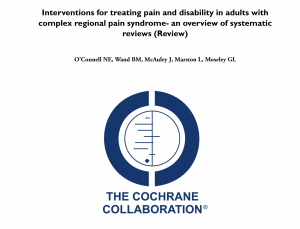
Authors: Neil E O’Connell, Benedict M Wand, James McAuley, Louise Marston, G Lorimer Moseley
Journal: Cochrane Database of Systematic Reviews
Abstract: Complex regional pain syndrome (CRPS) is characterised by persistent pain, usually in the hands or feet, that is not proportionate inseverity to any underlying injury. It often involves a variety of other symptoms such as swelling, discolouration, stiffness, weakness and changes to the skin. This over view sought to summarise and report all of the available evidence arising from systematic reviews for all treatments for this condition regarding how well they work and any potential harm that they might cause. We identified six Cochrane reviews and 13 non-Cochrane systematic reviews that included evidence relating to a broad range of treatments, from drugs to surgical procedures, rehabilitation and alternative therapies. For most treatments there were only a small number of published trials and the quality of these trials was mixed. As such, most of the evidence for most treatments is of low or very low quality and can not be regarded as reliable.We found low quality evidence that a daily course of the drug ketamine delivered intravenously may effectively reduce pain, although it is also associated with a variety of side effects. We found low quality evidence that the bisphosphonate class of drugs, calcitonin and programmes of graded motor imagery may be effective for CRPS, and that mirror therapy may be effective in people who develop CRPS after suffering a stroke. Low quality evidence suggested that physiotherapy and occupational therapy did not lead to clinically important benefits at one year follow up, and that blocking sympathetic nerves with local anaesthetic is not effective. There is moderate quality evidence that an intravenous regional blockade using the drug guanethidine is not effective and may be associated with complications.For a range of other interventions we found only very low quality evidence or no evidence at all. No conclusions should be drawn regarding the value of these interventions based on this level of evidence.Based on the existing evidence it is difficult to draw firm conclusions as to which therapies should be offered to patients with CRPS.Better quality research is vital to reduce uncertainty in this area and is necessary before confident recommendations can be made.
Link to Full Text
Degenerative Disc Disease
Title: Cell-Based Therapies Used to Treat Lumbar Degenerative Disc Disease: A Systematic Review of Animal Studies and Human Clinical Trials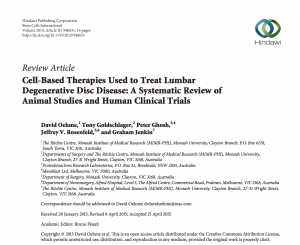
Authors: David Oehme, Tony Goldschlager, Peter Ghosh, Jeffrey V. Rosenfeld, and Graham Jenkin
Journal: Stem Cells International
Abstract: Low back pain and degenerative disc disease are a significant cause of pain and disability worldwide. Advances in regenerative medicine and cell-based therapies, particularly the transplantation of mesenchymal stem cells and intervertebral disc chondrocytes, have led to the publication of numerous studies and clinical trials utilising these biological therapies to treat degenerative spinal conditions, often reporting favourable outcomes. Stem cell mediated disc regeneration may bridge the gap between the two current alternatives for patients with low back pain, often inadequate pain management at one end and invasive surgery at the other. Through cartilage formation and disc regeneration or via modification of pain pathways stem cells are well suited to enhance spinal surgery practice. This paper will systematically review the current status of basic science studies, preclinical and clinical trials utilising cell-based therapies to repair the degenerate intervertebral disc. The mechanism of action of transplanted cells, as well as the limitations of published studies, will be discussed.
Link to Full Text
Depression
Title: Glutamate Receptor Antagonists as Fast-Acting Therapeutic Alternatives for the Treatment of Depression: Ketamine and Other Compounds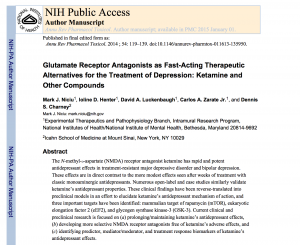
Authors: Mark J. Niciu, Ioline D. Henter, David A. Luckenbaugh, Carlos A. Zarate Jr., and Dennis S. Charney
Journal: Annu Rev Pharmacol Toxicol.
Abstract: The N-methyl-d-aspartate (NMDA) receptor antagonist ketamine has rapid and potent antidepressant effects in treatment-resistant major depressive disorder and bipolar depression. These effects are in direct contrast to the more modest effects seen after weeks of treatment with classic monoaminergic antidepressants. Numerous open-label and case studies similarly validate ketamine’s antidepressant properties. These clinical findings have been reverse-translated into preclinical models in an effort to elucidate ketamine’s antidepressant mechanism of action, and three important targets have been identified: mammalian target of rapamycin (mTOR), eukaryotic elongation factor 2 (eEF2), and glycogen synthase kinase-3 (GSK-3). Current clinical and preclinical research is focused on (a) prolonging/maintaining ketamine’s antidepressant effects, (b) developing more selective NMDA receptor antagonists free of ketamine’s adverse effects, and (c) identifying predictor, mediator/moderator, and treatment response biomarkers of ketamine’s antidepressant effects.
Link to Full Text
Title: Ketamine-induced affective switch in a patient with treatment-resistant depression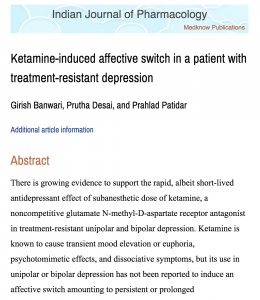
Authors: Girish Banwari, Prutha Desai, and Prahlad Patidar
Journal: Indian Journal of Pharmacology
Abstract: There is growing evidence to support the rapid, albeit short-lived antidepressant effect of subanesthetic dose of ketamine, a noncompetitive glutamate N-methyl-D-aspartate receptor antagonist in treatment-resistant unipolar and bipolar depression. Ketamine is known to cause transient mood elevation or euphoria, psychotomimetic effects, and dissociative symptoms, but its use in unipolar or bipolar depression has not been reported to induce an affective switch amounting to persistent or prolonged hypomania/mania or manic-like syndrome. We report the case of a 52-year-old male with first episode, continuous, nonpsychotic, treatment-resistant, unipolar major depression of 10 years duration, who manifested a switch from depression to mania while being treated with subanesthetic dose of ketamine, given intramuscularly. This case suggests that polarity switch should be considered as a potential side effect while using ketamine for treatment-resistant depression.
Link to Full Text
Title: Antidepressant Efficacy of Ketamine in Treatment-Resistant Major Depression: A Two-Site Randomized Controlled Trial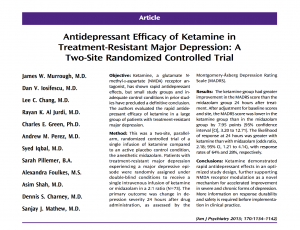
Authors: James W. Murrough, , M.D., Dan V. Iosifescu, , M.D., Lee C. Chang, , M.D., Rayan K. Al Jurdi, , M.D., Charles E. Green, , Ph.D., Andrew M. Perez, , M.D., Syed Iqbal, , M.D., Sarah Pillemer, , B.A., Alexandra Foulkes, , M.S., Asim Shah, , M.D., Dennis S. Charney, , M.D., Sanjay J. Mathew, , M.D.
Journal: American Journal of Psychiatry
Abstract:Intravenous ketamine demonstrated rapid antidepressant effects in an optimized study design, improving depression severity in 64% of treatment-resistant patients 24 hours after a single dose. The double-blind trial provides evidence for the role of the N-methyl-d-aspartate glutamate receptor in depression, a receptor not currently activated by existing antidepressant drugs.
Objective
Ketamine, a glutamate N-methyl-d-aspartate (NMDA) receptor antagonist, has shown rapid antidepressant effects, but small study groups and inadequate control conditions in prior studies have precluded a definitive conclusion. The authors evaluated the rapid antidepressant efficacy of ketamine in a large group of patients with treatment-resistant major depression.
Method
This was a two-site, parallel-arm, randomized controlled trial of a single infusion of ketamine compared to an active placebo control condition, the anesthetic midazolam. Patients with treatment-resistant major depression experiencing a major depressive episode were randomly assigned under double-blind conditions to receive a single intravenous infusion of ketamine or midazolam in a 2:1 ratio (N=73). The primary outcome was change in depression severity 24 hours after drug administration, as assessed by the Montgomery-Åsberg Depression Rating Scale (MADRS).
Results
The ketamine group had greater improvement in the MADRS score than the midazolam group 24 hours after treatment. After adjustment for baseline scores and site, the MADRS score was lower in the ketamine group than in the midazolam group by 7.95 points (95% confidence interval [CI], 3.20 to 12.71). The likelihood of response at 24 hours was greater with ketamine than with midazolam (odds ratio, 2.18; 95% CI, 1.21 to 4.14), with response rates of 64% and 28%, respectively.
Conclusions
Ketamine demonstrated rapid antidepressant effects in an optimized study design, further supporting NMDA receptor modulation as a novel mechanism for accelerated improvement in severe and chronic forms of depression. More information on response durability and safety is required before implementation in clinical practice.
Link to Full Text
Title: Intravenous Therapies in the Management of Neuropathic Pain: A Review on the Use of Ketamine and Lidocaine in Chronic Pain Management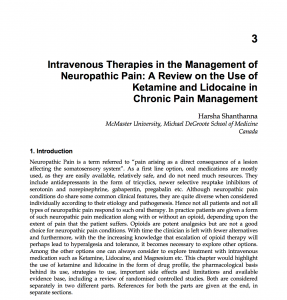
Authors: Harsha Shanthanna
Journal: Neuropathic Pain
Abstract: Neuropathic Pain is a term referred to “pain arising as a direct consequence of a lesion affecting the somatosensory system”. As a first line option, oral medications are mostly used, as they are easily available, relatively safe, and do not need much resources. They include antidepressants in the form of tricyclics, newer selective reuptake inhibitors of serotonin and norepinephrine, gabapentin, pregabalin etc. Although neuropathic pain conditions do share some common clinical features, they are quite diverse when considered individually according to their etiology and pathogenesis. Hence not all patients and not all types of neuropathic pain respond to such oral therapy. In practice patients are given a form of such neuropathic pain medication along with or without an opioid, depending upon the extent of pain that the patient suffers. Opioids are potent analgesics but are not a good choice for neuropathic pain conditions. With time the clinician is left with fewer alternatives and furthermore, with the the increasing knowledge that escalation of opioid therapy will perhaps lead to hyperalgesia and tolerance, it becomes necessary to explore other options. Among the other options one can always consider to explore treatment with intravenous medication such as Ketamine, Lidocaine, and Magnesium etc. This chapter would highlight the use of ketamine and lidocaine in the form of drug profile, the pharmacological basis behind its use, strategies to use, important side effects and limitations and available evidence base, including a review of randomised controlled studies. Both are considered separately in two different parts. References for both the parts are given at the end, in separate sections.
Link to Full Text
Post-Treatment Lyme Syndrome
Title: Post-Treatment Lyme Syndrome and Central Sensitization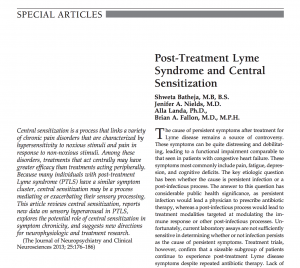
Authors: Shweta Batheja, , M.B, B.S., Jenifer A. Nields, , M.D., Alla Landa, , Ph.D., Brian A. Fallon, , M.D., M.P.H.
Journal: Journal of Neuropsychiatry
Abstract: The authors of this clinically important article describe the process whereby chronic Lyme disease and its CNS sequelae can result in various treatment-resistant pain and anxiety disorders that are characterized by hypersensitivity to noxious and non-noxious stimuli. These may include skin reactions, fatigue, muscle weakness, extreme sensitivity to sound or smell, and, also, mood and cognitive symptoms. The article reviews several treatment approaches beyond antibiotics, including antidepressants and anti-epileptic drugs.
Central sensitization is a process that links a variety of chronic pain disorders that are characterized by hypersensitivity to noxious stimuli and pain in response to non-noxious stimuli. Among these disorders, treatments that act centrally may have greater efficacy than treatments acting peripherally. Because many individuals with post-treatment Lyme syndrome (PTLS) have a similar symptom cluster, central sensitization may be a process mediating or exacerbating their sensory processing. This article reviews central sensitization, reports new data on sensory hyperarousal in PTLS, explores the potential role of central sensitization in symptom chronicity, and suggests new directions for neurophysiologic and treatment research.
Link to Full Text
Herniated Disc Pain
Title: Medical Ozone in Herniated Disc: A Classical Review
Authors: Sardar K, Das G, Mahta P, Mallick S and Hubbard R
Journal: Pain & Relief
Abstract: Back pain associated with herniated disks has become an important and increasing general health problem across the world. After all methods of conservative treatment have been exhausted, nucleolysis may be a minimally invasive alternative to surgery. In nucleolysis, chondrolytic substances, or other substances which reduce the pressure within the disk by other means, are injected into the nucleus pulposus under CT scan or fluroscopic guidance. Among various substances, which have been employed for nucleolysis, an ozone-oxygen mixture appears to be very promising. The water-binding capacity of ozone results in a reduction of pain. Moreover, it has an anti-inflammatory effect and results in an increase of perfusion to the affected area. Ozone is converted into pure oxygen in the body and has a low allergic potential. Recent minimally invasive therapeutic methods such as percutaneous nucleotomy or laser treatment have not been shown to result in superior results compared with ozone nucleolysis.
Link to Full Text
Facet Joint Pain
Title: A Systematic Review and Best Evidence Synthesis of Effectiveness of Therapeutic Facet Joint Interventions in Managing Chronic Spinal Pain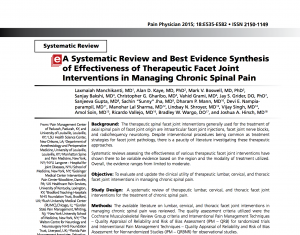
Authors: Laxmaiah Manchikanti, MD, Alan D. Kaye, MD, PhD, Mark V. Boswell, MD, PhD, Sanjay Bakshi, MD, Christopher G. Gharibo, MD, Vahid Grami, MD, Jay S. Grider, DO, PhD, Sanjeeva Gupta, MD, Sachin “Sunny” Jha, MD, Dharam P. Mann, MD, Devi E. Nampiaparampil, MD, Manohar Lal Sharma, MD, Lindsay N. Shroyer, MD, Vijay Singh, MD, Amol Soin, MD, Ricardo Vallejo, MD, Bradley W. Wargo, DO, and Joshua A. Hirsch, MD
Journal: Pain Physician
Abstract: Background: The therapeutic spinal facet joint interventions generally used for the treatment of axial spinal pain of facet joint origin are intraarticular facet joint injections, facet joint nerve blocks, and radiofrequency neurotomy. Despite interventional procedures being common as treatment strategies for facet joint pathology, there is a paucity of literature investigating these therapeutic approaches. Systematic reviews assessing the effectiveness of various therapeutic facet joint interventions have shown there to be variable evidence based on the region and the modality of treatment utilized. Overall, the evidence ranges from limited to moderate.
Link to Full Text
Fibromyalgia
Title: Review of pharmacological therapies in fibromyalgia syndrome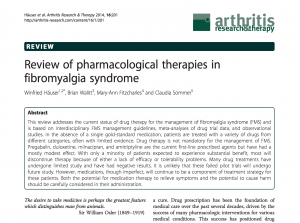
Authors: Winfried Häuser, Brian Walitt, Mary-Ann Fitzcharles and Claudia Sommer
Journal: Arthritis Research & Therapy
Abstract: This review addresses the current status of drug therapy for the management of fibromyalgia syndrome (FMS) and is based on interdisciplinary FMS management guidelines, meta-analyses of drug trial data, and observational studies. In the absence of a single gold-standard medication, patients are treated with a variety of drugs from different categories, often with limited evidence. Drug therapy is not mandatory for the management of FMS. Pregabalin, duloxetine, milnacipran, and amitriptyline are the current first-line prescribed agents but have had a mostly modest effect. With only a minority of patients expected to experience substantial benefit, most will discontinue therapy because of either a lack of efficacy or tolerability problems. Many drug treatments have undergone limited study and have had negative results. It is unlikely that these failed pilot trials will undergo future study. However, medications, though imperfect, will continue to be a component of treatment strategy for these patients. Both the potential for medication therapy to relieve symptoms and the potential to cause harm should be carefully considered in their administration.
Link to Full Text
Migraine Pain
Title: Surgical treatment for migraine: Time to fight against the knife
Authors: HC Diener and U Bingel
Journal: Cephalalgia
Abstract: Migraine can be a disabling disease if migraine attacks are frequent and severe (1). Frequent migraine requires preventive therapy by drug treatment (2) in combination with counselling, behavioural therapy or exercise. As in all chronic diseases, patients are inclined to search for the ultimate treatment that supposedly cures the condition. Here comes the attraction of surgical or interventional therapy. Patients with poor understanding of the complex pathophysiology of migraine tend to believe that surgical or interventional procedures might be effective in migraine with only minor or no longterm adverse events and fail to apply the necessary lifestyle modifications. In this editorial we will briefly discuss the missing evidence for the surgical treatment of trigger sites, chronic bilateral occipital nerve stimulation (ONS) and patent foramen ovale (PFO) closure and discuss the impact of the placebo effect in studies with surgical interventions.
Link to Full Text
Post Laminectomy Syndrome
Title: Interventional Pain Management for Failed Back Surgery Syndrome 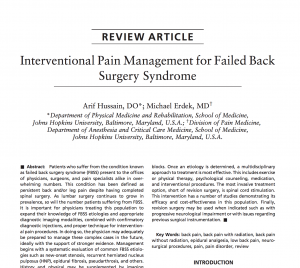
Authors: Arif Hussain, DO; Michael Erdek, MD
Journal: Pain Practice
Abstract: Patients who suffer from the condition known as failed back surgery syndrome (FBSS) present to the offices of physicians, surgeons, and pain specialists alike in overwhelming
numbers. This condition has been defined as persistent back and/or leg pain despite having completed spinal surgery. As lumbar surgery continues to grow in prevalence, so will the number patients suffering from FBSS. It is important for physicians treating this population to expand their knowledge of FBSS etiologies and appropriate diagnostic imaging modalities, combined with confirmatory diagnostic injections, and proper technique for interventional pain procedures. In doing so, the physician may adequately be prepared to manage these complex cases in the future,
ideally with the support of stronger evidence. Management begins with a systematic evaluation of common FBSS etiologies such as new-onset stenosis, recurrent herniated nucleus pulposus (HNP), epidural fibrosis, pseudarthrosis, and others. History and physical may be supplemented by imaging including X-ray, magnetic resonance imaging, or computed tomography myelography. Certain diagnoses may be confirmed with diagnostic procedures such as intra-articular injections, medial branch blocks, or transforaminal nerve root blocks. Once an etiology is determined, a multidisciplinary approach to treatment is most effective. This includes exercise or physical therapy, psychological counseling, medication, and interventional procedures. The most invasive treatment option, short of revision surgery, is spinal cord stimulation.
This intervention has a number of studies demonstrating its efficacy and cost-effectiveness in this population. Finally, revision surgery may be used when indicated such as with progressive neurological impairment or with issues regarding previous surgical instrumentation.
Link to Full Text
Sciatica
Title: Assessment of Patient-Specific Surgery Effect Based on Weighted Estimation and Propensity Scoring in the Re-Analysis of the Sciatica Trial 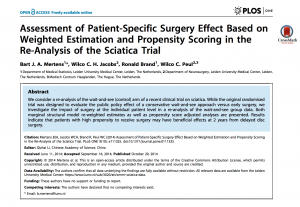
Authors: Bart J. A. Mertens, Wilco C. H. Jacobs, Ronald Brand, Wilco C. Peul
Journal: PLOS ONE
Abstract: We consider a re-analysis of the wait-and-see (control) arm of a recent clinical trial on sciatica. While the original randomised trial was designed to evaluate the public policy effect of a conservative wait-and-see approach versus early surgery, we investigate the impact of surgery at the individual patient level in a re-analysis of the wait-and-see group data. Both marginal structural model re-weighted estimates as well as propensity score adjusted analyses are presented. Results indicate that patients with high propensity to receive surgery may have beneficial effects at 2 years from delayed disc surgery.
Link to Full Text
Postherpetic Neuralgia
Title: Postherpetic Neuralgia 
Authors: Alan David Kaye and Charles E. Argoff
Journal: Neurological Disorders
Abstract: A 78-year-old male with a history of postherpetic neuralgia (PHN) as well as hypertension presents to your office with complaints of moderate to severe pain (intensity 7/10) along the right T8 dermatome. He experienced acute herpes zoster (shingles) in this region 3 years ago and was treated at that time with acyclovir
and analgesics. The pain never dissipated and for the past 3 years he has been treated with a variety of medications, including immediate-release gabapentin, nortriptyline, and the 5% lidocaine patch as well as unsuccessful treatment with various nerve blocks and a trial of spinal stimulation.
Link to Full Text
Sacroiliac Joint Pain
Title: Radiofrequency Neurotomy for Sacroiliac Joint Pain: A Prospective Study 
Authors: Bruce Mitchell, Tomas MacPhail, David Vivian, Paul Verrills, Adele Barnard
Journal: Surgical Science
Abstract: Background: The sacroiliac joint (SIJ) is an important cause of chronic low back pain, implicated in 15% – 30% of all cases. While radiofrequency neurotomy (RFN) is the interventional treatment of choice for spinal pain originating from the facet joints, fewer studies have investigated its potential for treating SIJ pain, and its long-term efficacy is unknown. Objectives: To obtain a real-world view of RFN treatment outcomes for SIJ pain by conducting an observational study within a community pain practice, among a heterogeneous patient group receiving standard-of-care diagnostic workup and treatment. Study Design: A prospective, observational study, with data collection over five years, was conducted at the authors’ private practice. Patients & Methods: A cohort of 215 patients underwent fluoroscopically guided SIJ RFN of the dorsal and lateral branches of S1-S3 and the descending branch of L5. All patients had previously had their diagnosis of SIJ pain confirmed by controlled comparative analgesic blocks of relevant nerves, and recorded pre-procedure pain levels on the 11-point Numerical Rating Scale (NRS). Outcome measures included pain, and a Likert scale to measure alterations to analgesic use, changes to paid employment status and patient satisfaction. Results: We demonstrate an average pain reduction of 2.3 ± 2.1 NRS points following RFN (baseline pain score of 6.9 ± 1.7 to a follow-up average of 4.6 ± 2.7 NRS points; p ≤ 0.01). At a mean follow-up period of 14.9 ± 10.9 months (range 6 – 49 months), an overall 42.2% of patients reduced their analgesic use. Of the patients for whom employment capacity was applicable (82 patients), 21 patients reported an improvement. Overall, 67% of patients were satisfied with their outcome of post-RFN treatment. No complications occurred. Limitations: This observational study had no independent control group and only included a single study site. Conclusions: RFN is a safe and effective treatment for pain confirmed to originate from the sacroiliac joint.
Link to Full Text
Spinal Stenosis
Title: Changes in Attitudes toward Lumbar Spinal Stenosis Treatment 
Authors: Shin-ichi Konno, Miho Sekiguchi
Journal: Open Journal of Orthopedics
Abstract: As the environment surrounding healthcare continues to evolve, there is a need to revise outcome assessment criteria. A shift is being demanded in diagnosis and treatment outcome assessment practices from objective to subjective assessment and from evaluation by doctors to assessment that is based on the patient’s own perspective. Therefore, lumbar diseases must now be assessed from multiple perspectives. Some major indices for evaluation are pain and numbness, functional status, general health status, disability, and patient satisfaction. An effective assessment method for lumbar spinal stenos is that examines symptoms, quality of life, and healthcare economics as key assessment factor is reviewed.
Link to Full Text
Scoliosis
Title: Controlled-Release Curcumin for the Treatment of Pain Related to Adult Degenerative Scoliosis: A Retrospective, Open-Label, Case-Controlled Series
Authors: Morningstar MW, Megan Strauchman and Gretchen Fleischmann
Journal: Pain & Relief
Abstract: Background: Patients with adult degenerative scoliosis often experience chronic recurrent back and/or hip pain. This is a very common reason that this patient population seeks treatment. Few treatments are typically offered to adult patients with scoliosis. Of these, the more common are pharmacologic pain management, and epidural injections in more severe cases. The goal of this study was to compare two groups of patients who participated in a scoliosisspecific
rehabilitation program. One group additionally took a proprietary curcumin supplement concurrent with therapy. We compared the results of the two groups. Methods: The results of four consecutive patients with the same diagnosis who took a controlled-release curcumin following a trial of exercise-based scoliosis treatment were collected retrospectively. Outcome assessments included
the Cobb angle of the primary curvature, quadruple numerical pain rating scale, and goniometric ranges of motion. Their results were compared against four patients who decided not to take the curcumin formula during their exercise based treatment. Results: Patients taking the curcumin supplement reported larger average improvements in quadruple numerical pain rating scale taken at baseline and 6 months. Comparative Cobb angles showed similar clinical improvements in the treatment and control groups at 6 months. Conclusion: Patients taking curcumin daily for 6 months after completing an exercise-based treatment reported statistically significant pain scale improvements compared to baseline and controls. Multiple metabolic and neurologic pathways may account for the observed improvement.
Link to Full Text
